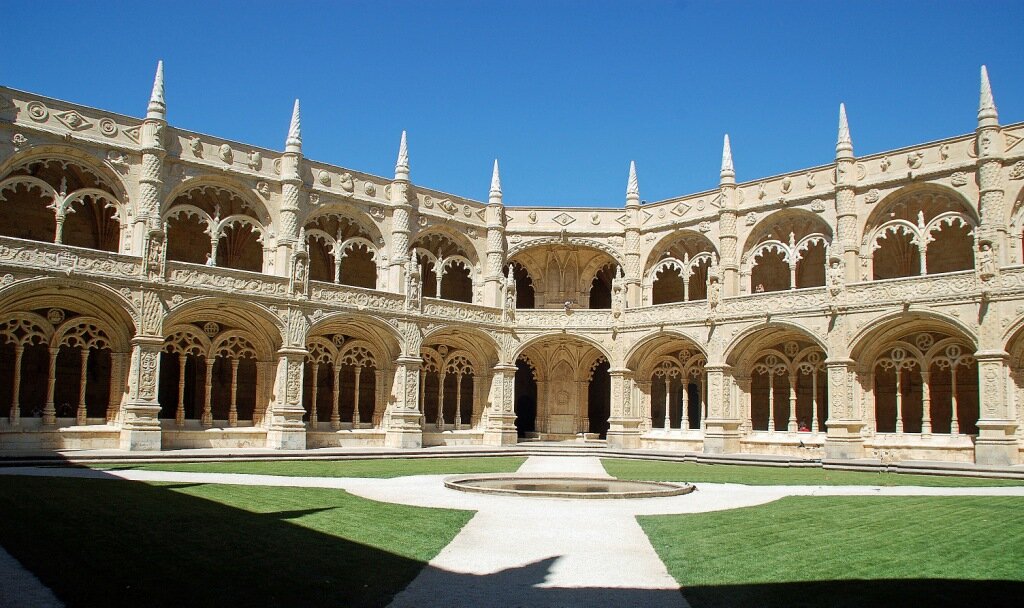The Great Age of Exploration, Portugal
The pioneer country of the Great Age of Exploration in the 15th and 16th centuries was Portugal, followed by Spain. So, one morning at the end of October I found myself in Lisbon, delighted by the narrative of a long-time friend, Ioannis Metaxas, Ambassador of Greece to Portugal.
The spectacular Marquès de Pombal Square in Lisbon.
Step by step I started to discover with my own eyes the places that once made Lisbon the wealthiest city in Europe when the caravels entered its port loaded with exotic goods from the East, especially spices; and with its rapidly acquired gold, the churches, the palaces and the monasteries of the country were adorned.
The Belém district on the banks of the Tagus River was part of my exploration, before my cruise on the coast would start, where Mrs. Margarita Adamos, Counselor at the Embassy of Greece, was so gracious to accompany me, and with her profound knowledge to show me details that I have never imagined.
The Tower of Belém in Lisbon.
The Tower of Belém was erected in the 16th century on the river bank as a symbol of the Great Age of Exploration. An amalgam of styles: Gothic structure, a Renaissance loggia in the inner courtyard and Moorish watchtowers above the water, all decorated in Manueline-style motifs such as nautical ropes, little caravels and armillary spheres.
The Tower was also used as a fort to prevent enemies from entering the Tagus; but with my enchanted eyes, I saw the opposite direction, that is, the mouth of the river to the Atlantic Ocean which I presume the first explorers would have watched, enchanted too. An infinite ocean, full of mystery - was there an end to this aquatic spectacle?
Τhe news of Christopher Columbus of the discovery of the Americas spread out all over Europe as a thunderbolt. More astonished was the King of Portugal. Anxious that the Spaniards would take the lead in exploring maritime routes, and therefore lucrative trade, he sent off to the coast of West Africa the 28-year-old Vasco da Gama to find the coveted seaway to the Indian Ocean, which was not sure even existed.
The Tomb of Vasco da Gama in the Jerónimos Monastery in Belém, Lisbon.
So, my highly knowledgeable friend made a leap into History and with her fascinating narrative she took me straight to the tomb of the great explorer in the Monastery of Jerónimos, leaving me to discover his voyage to the Indian Ocean in the next cruise organized by Variety Cruises.
I confess that the tomb of Vasco da Gama made me silent for a few moments, all decorated in Manueline-style ornamentation after King Manuel I that, as I wrote, three were its most significant features: the nautical ropes, the little caravel and the armillary sphere.
The 16th-century cloister of the Monastery of Jerónimos in Belém, Lisbon.
Leaving behind us the impressive monastery, the most beautiful I have seen in Europe, a pilgrimage to the Monument to the Discoveries, Padrâo dos Descrobrimentos, was a must. The white plaster group of thirty-three figures representing the great men of the Age of Discovery looking straight ahead and standing on the prow of a caravel was the introduction to the sea route I would follow on the cruise: “The Glories of Portugal and Spain”, which for me was not only a delight to the eyes, but a shake-up of my mind and soul, as I suppose, it would have been, or rather felt by the first explorers.
The Monument of the Discoveries on the northern bank of the Tagus River estuary, Lisbon.
Travel with my Books in English
Cruise theme: “The Glories of Portugal and Spain” www.varietycruises.com





